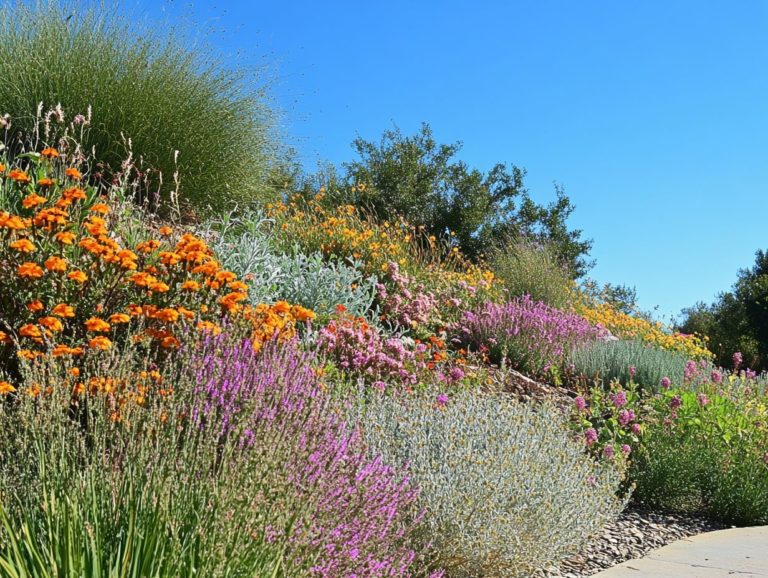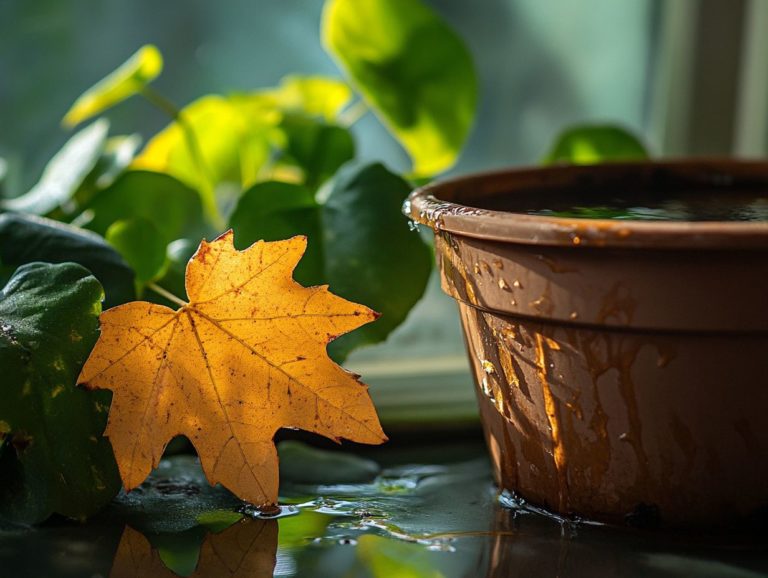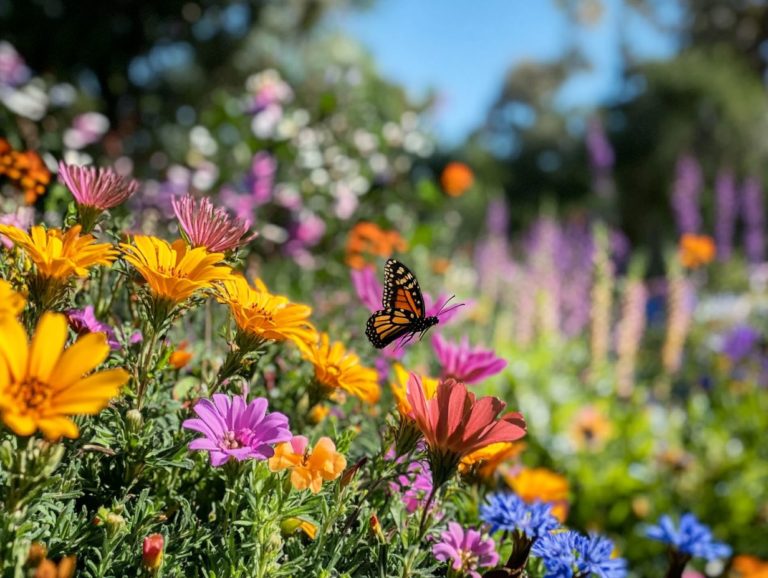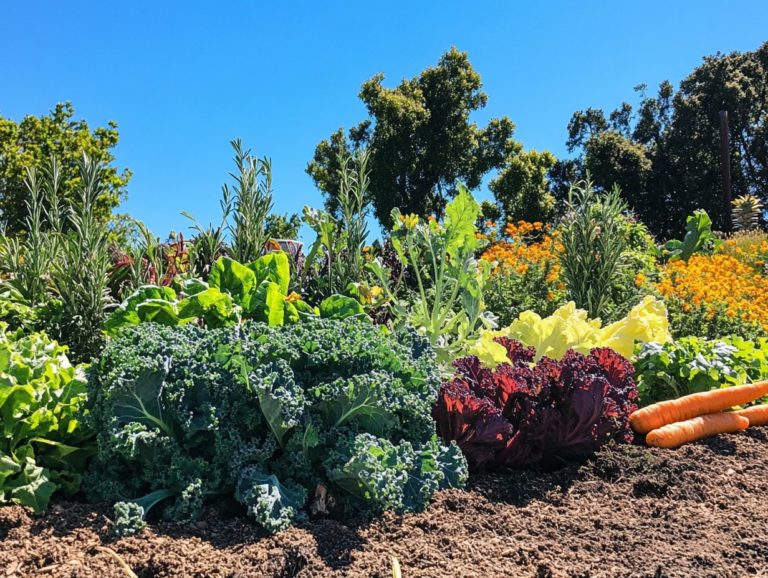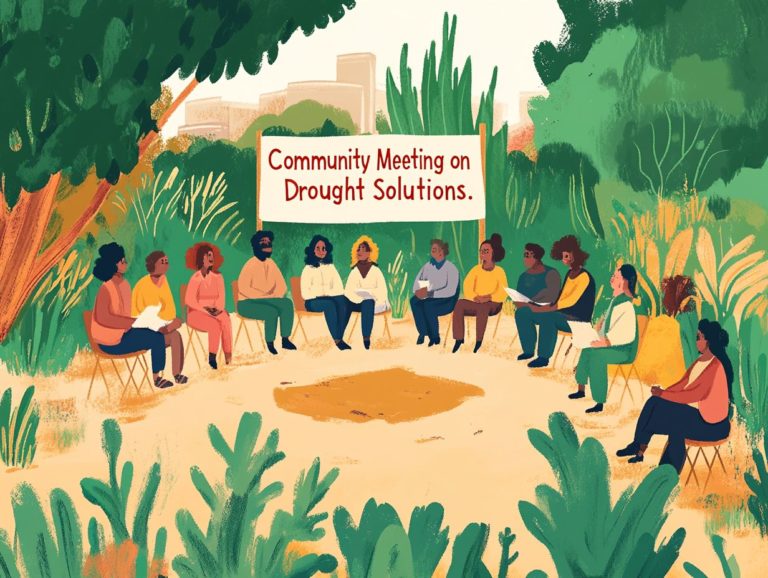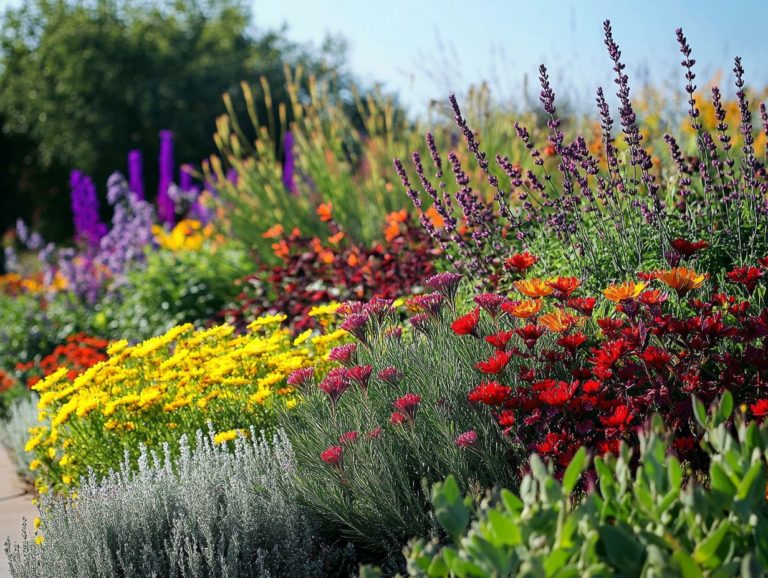How Do Drought-Resistant Plants Adapt to Arid Conditions?
Drought-resistant plants are nature s remarkable survivors, flourishing in arid conditions where others struggle to survive.
By grasping their unique adaptations both physical and biological you can revolutionize your approach to gardening and landscaping. This is especially true in water-scarce regions.
This article delves into a range of drought-resistant plants, including xerophytes (plants adapted to dry environments), halophytes (plants that thrive in salty soils), and phreatophytes (plants that grow near water sources). It offers essential care tips and emphasizes the environmental and economic benefits of integrating these resilient species into your outdoor spaces.
Discover how these hardy plants, including creosote bush and rock daisies, can transform your garden into a vibrant oasis while contributing to a more sustainable lifestyle.
Contents
- Key Takeaways:
- What Makes a Plant Drought-Resistant?
- Adaptations of Drought-Resistant Plants
- Common Drought-Resistant Plants
- How to Care for Drought-Resistant Plants
- Watering and Maintenance Tips
- Benefits of Using Drought-Resistant Plants
- Frequently Asked Questions
- What are drought-resistant plants and how do they adapt to arid conditions?
- What are some physical adaptations of drought-resistant plants?
- How do drought-resistant plants conserve water?
- Do drought-resistant plants have any behavioral adaptations?
- Can drought-resistant plants be grown in areas without extreme dryness?
- How can I incorporate drought-resistant plants into my landscaping?
Key Takeaways:
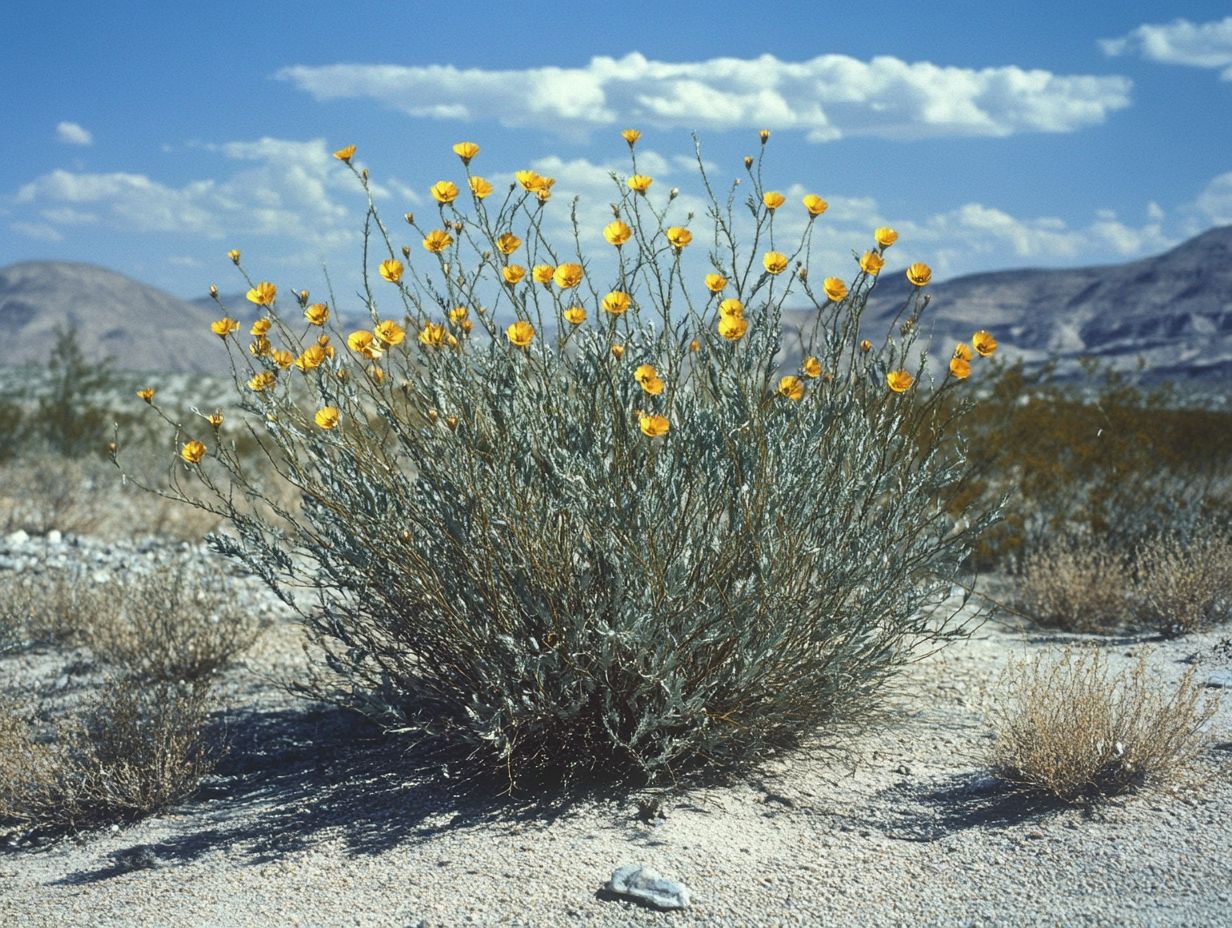
- Drought-resistant plants have adaptations for arid conditions.
- Examples include cacti, succulents, the Joshua tree, and deep-rooted grasses.
- Care involves deep, infrequent watering and good drainage.
What Makes a Plant Drought-Resistant?
Drought-resistant plants, often known as drought-tolerant plants, have developed fascinating adaptations that allow them to thrive in arid environments marked by water scarcity. If you’re curious about the most resilient drought-resistant plants, these remarkable specimens feature specialized structures and physiological processes that enable them to efficiently store water, minimize loss, and endure environmental stressors like extreme heat and extended dry spells.
Take the iconic Joshua tree, for example. It perfectly illustrates how desert flora has evolved to flourish in harsh conditions, showcasing the extraordinary adaptations that make these plants exemplary models of water conservation.
Adaptations of Drought-Resistant Plants
Adaptations of drought-resistant plants showcase an impressive array of physical and biological traits that enable them to flourish in the harsh conditions typical of arid environments. Understanding how drought-resistant plants save water is vital for their survival, enabling them to efficiently manage water storage, reduce water loss, and sustain essential processes like photosynthesis, even when confronted with significant environmental stressors.
Notably, deep roots, thickened leaves, and specialized stomata are instrumental in enhancing these plants’ competitive advantage, ensuring they endure prolonged droughts while simultaneously bolstering the resilience of the ecosystem.
Physical Adaptations
Physical adaptations in drought-resistant plants are crucial for their survival in harsh environments, allowing them to manage water resources with remarkable efficiency through specialized structures. You’ll find adaptations such as thick, fleshy leaves designed for water storage, extensive root systems that penetrate deep into the soil to tap into groundwater, and waxy coatings that significantly reduce water loss.
These modifications grant these plants a competitive edge, enabling them to thrive in water-scarce regions.
Take succulents, for instance. Their swollen stems and leaves are prime examples of how these plants store moisture in arid conditions. The thick cuticles they possess minimize evaporation, while shallow yet widespread roots maximize their ability to capture the rare rainfall that comes their way.
Similarly, the Joshua tree boasts an impressive root system that can stretch far underground, helping it access elusive water tables. These adaptations not only ensure their survival but also nurture entire ecosystems, fostering biodiversity by providing shelter and nutrients in environments where few plants can endure.
Biological Adaptations
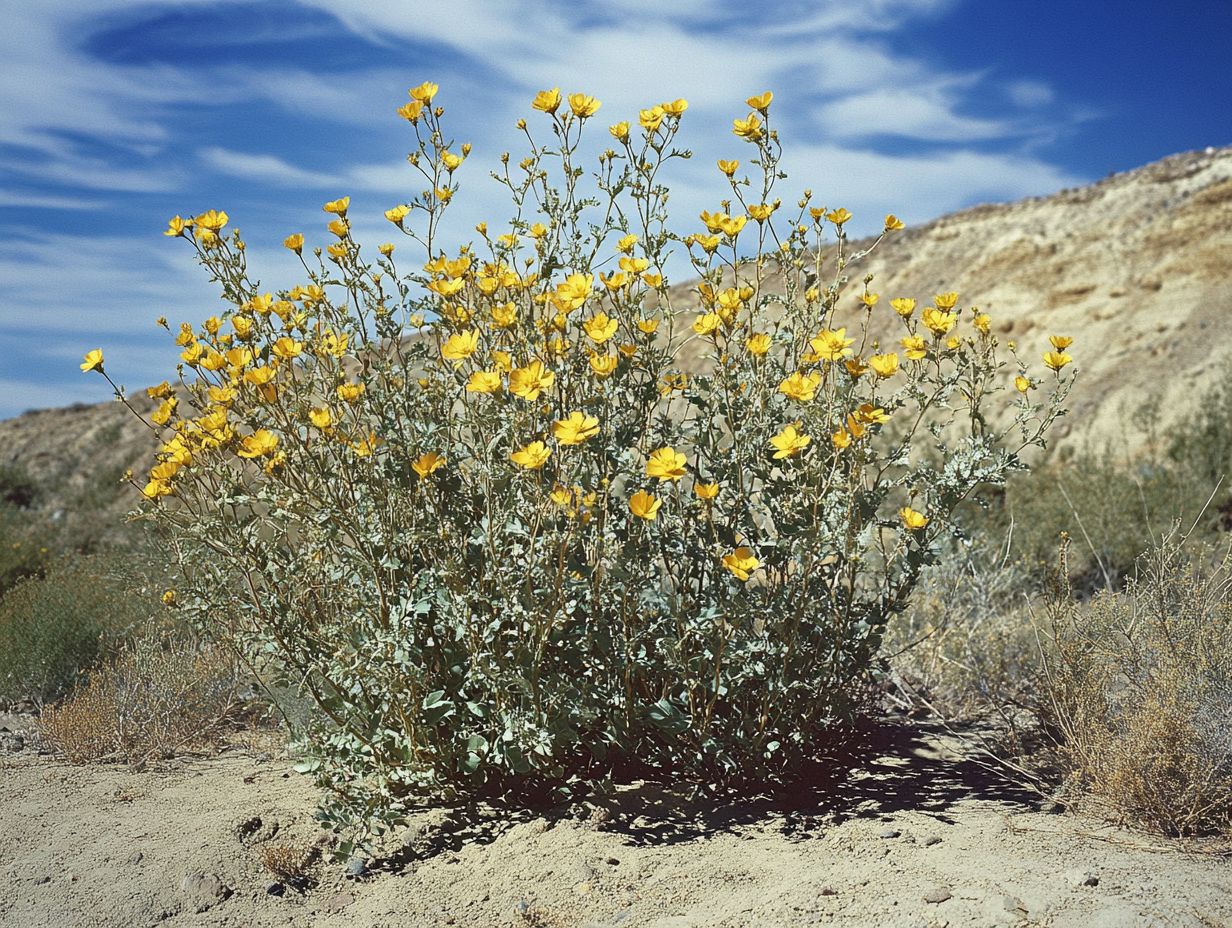
The biological adaptations of drought-resistant plants showcase intricate physiological processes that enhance their ability to endure environmental stressors, such as limited water availability and extreme temperatures. For instance, learning how to identify drought-resistant plants quickly can highlight adaptations like efficient photosynthesis methods that minimize water loss.
Additionally, plants produce protective compounds to neutralize free radicals. They have mechanisms that allow for dormancy, a period when the plant stops growing, during the driest periods. Such strategies not only support survival but also contribute to the ecological balance within their native ecosystems.
Consider Crassulacean Acid Metabolism (CAM) photosynthesis. This remarkable adaptation enables certain plants to open their stomata at night instead of during the sweltering day. This significantly cuts down on water loss. Similarly, halophytes, which flourish in saline environments, have developed specialized adaptations like salt excretion mechanisms and robust antioxidant systems to combat oxidative stress from high salinity.
These adaptations are becoming increasingly crucial as climate change intensifies. Unpredictable weather and arid conditions amplify the challenges that plants encounter. By investigating these mechanisms, researchers are striving to uncover innovative strategies that could bolster crop resilience and secure food supplies in our evolving world.
Common Drought-Resistant Plants
Common drought-resistant plants, like the iconic Joshua tree, a variety of succulents, creosote bush, and rock daisies, beautifully illustrate the diversity and resilience of flora adapted to arid conditions. To maximize their potential, it’s important to learn how to prepare soil for drought-resistant plants. Each species possesses unique traits that enhance their ability to conserve water and thrive with minimal moisture.
Take the Joshua tree; its extensive root system allows it to access deep groundwater reserves. Succulents excel at storing significant amounts of water within their fleshy tissues. These remarkable adaptations demonstrate how these plants not only survive but truly flourish in the face of environmental challenges.
Examples and Characteristics
Key examples of drought-resistant plants include:
- Joshua tree
- Succulents
- Creosote bush
Each showcases unique characteristics that enable their survival in arid climates.
The Joshua tree, with its spiky, evergreen leaves, effectively minimizes water loss and attracts specific pollinators, such as the yucca moth. This moth plays a vital role in its reproduction and showcases its adaptations.
Succulents, ranging from the vibrant jade plant to the iconic agave, exhibit a remarkable ability to retain moisture due to their thickened tissues. They also engage in mutualistic relationships with certain insects that assist in their pollination.
Meanwhile, the creosote bush employs drought dormancy to conserve resources. It releases chemical compounds that inhibit the growth of neighboring plants, reducing competition for water.
These ecological interactions underscore the intricate web of life that these drought-tolerant species, including halophytes and phreatophytes, contribute to their ecosystems.
How to Care for Drought-Resistant Plants
Caring for drought-resistant plants requires a refined approach that amplifies their natural adaptations and promotes effective water conservation practices. It’s essential to grasp their unique watering needs. Over-watering can lead to root rot. Conversely, ensuring they receive sufficient moisture during their active growth phases is crucial.
Thoughtful maintenance techniques, such as mulching (covering the soil with a layer of material to retain moisture) and strategic soil amendments, can significantly bolster these plants’ resilience against climate fluctuations. This makes them a sophisticated choice for sustainable gardening and landscaping, marrying beauty with environmental mindfulness.
As climate change intensifies, understanding and cultivating drought-resistant plants is more important than ever! Start your journey to a vibrant, drought-friendly garden today!
Watering and Maintenance Tips
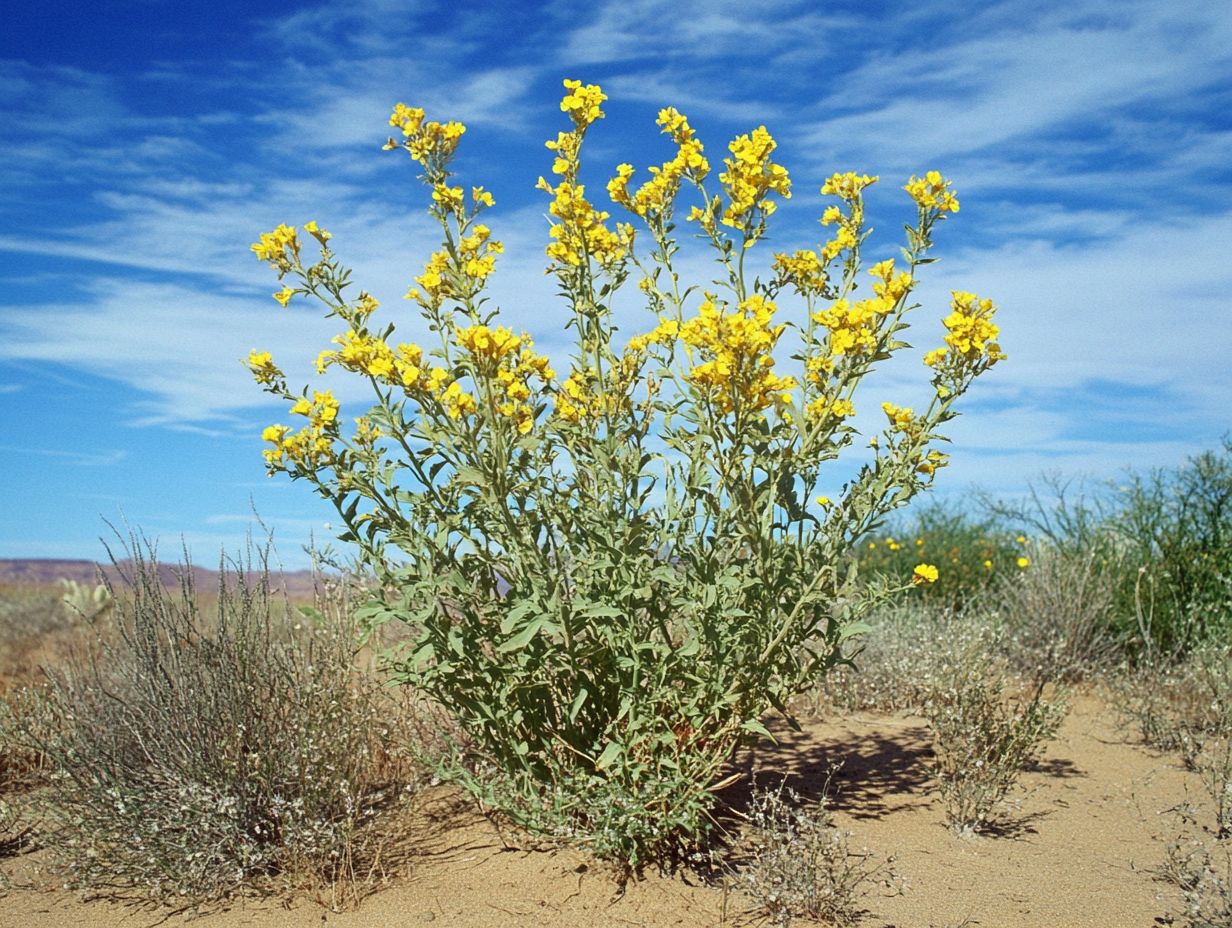
Effective watering and maintenance tips are crucial for keeping your drought-resistant plants healthy while conserving water in your garden. Consider strategies like deep watering less frequently. This encourages your plants to develop deeper root systems and boosts their drought resilience.
Using natural material that helps keep the soil moist is another great tactic. It retains soil moisture and shields plant roots from environmental stressors, further supporting these hardy species.
This approach reduces how often you need to water and allows the soil to absorb moisture more effectively during the cooler parts of the day. When you water, focus on the base of the plants to minimize evaporation and promote targeted hydration.
Healthy soil is key. Enriching it with organic matter can significantly enhance its structure and water retention capabilities.
By regularly monitoring soil moisture levels and using strategic mulching, you can create an environment that fosters the growth of drought-resistant varieties. Ultimately, this leads to a vibrant garden that thrives even under less-than-ideal conditions.
Benefits of Using Drought-Resistant Plants
Drought-resistant plants offer more than just good looks; they provide substantial environmental and economic benefits that align with sustainable landscaping practices, especially in areas like California, Arizona, and Texas.
Choosing these resilient species can significantly lower water consumption, foster biodiversity, and improve soil health in regions often affected by climate change. The reduced need for irrigation saves you time and effort while cutting long-term costs related to water usage.
Embracing drought-resistant plants is not just an environmentally conscious choice; it s a smart investment for any landscape.
Environmental and Economic Benefits
The environmental benefits of drought-resistant plants are remarkable. They are essential for conserving water and supporting local ecosystems. Their economic advantages can lead to significant cost savings.
These plants work wonders for soil health by improving its structure and fertility. This results in better water retention and nutrient cycling. They also create habitats for various species, boosting biodiversity and establishing a balanced ecosystem. A study from the University of California found that changing regular gardens to drought-resistant plants can reduce runoff by up to 90%, minimizing erosion and water pollution.
On the economic side, municipalities have reported reductions in irrigation costs of up to 30%, freeing up resources for other community needs. This showcases the comprehensive advantages of using these resilient plant species.
Frequently Asked Questions
What are drought-resistant plants and how do they adapt to arid conditions?
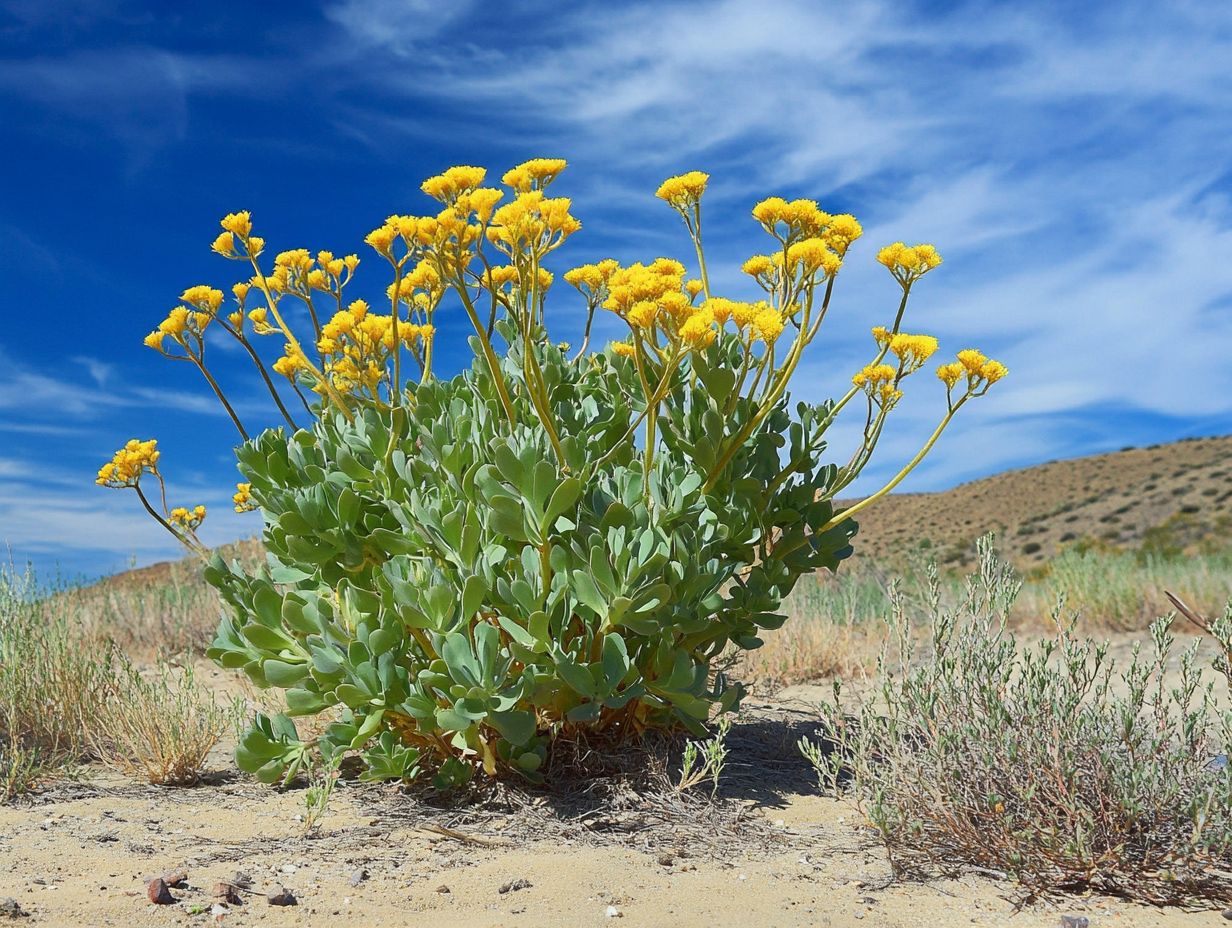
Drought-resistant plants are species that have evolved to survive in areas with limited water, such as deserts or arid regions. To learn more about which plants excel in these environments, explore the best drought-resistant plants that have various strategies to thrive in harsh conditions.
What are some physical adaptations of drought-resistant plants?
Drought-resistant plants have several physical adaptations that help them thrive in arid conditions. These include deep root systems to access groundwater, thick waxy cuticles to minimize water loss through transpiration, and small or spiky leaves to reduce surface area for evaporation. Understanding how do drought-resistant plants conserve moisture can provide further insights into their survival strategies.
How do drought-resistant plants conserve water?
Drought-resistant plants have developed mechanisms to conserve water, such as closing their stomata (pores) during hot and dry periods to reduce water loss through transpiration. If you’re interested in learning how to choose drought-resistant plants, you’ll find that they can also store water in their leaves, stems, or roots for later use.
Summary: Drought-resistant plants are essential for sustainable gardening. They save water, enhance soil quality, and support local wildlife. Don t wait! Start incorporating drought-resistant plants today for a lush, sustainable garden!
Explore our selection of drought-resistant plants today and transform your garden into a vibrant oasis!
Do drought-resistant plants have any behavioral adaptations?
Yes, drought-resistant plants adapt their growth cycles to match times of higher water availability. To further support these plants, it’s important to know how to keep drought-resistant plants healthy. This strategy helps them save water during dry periods and utilize moisture when it’s present.
Can drought-resistant plants be grown in areas without extreme dryness?
Absolutely! You can grow drought-resistant plants in many environments, even those without severe dryness. Just note that they might not adapt as well as those in dry areas and may need a little extra care.
How can I incorporate drought-resistant plants into my landscaping?
Incorporating drought-resistant plants is easy! Use them as accent plants in rock gardens, create a low-water garden, or use them as ground cover in areas with poor soil.
For the best results, talk to a local gardening expert about which plants are perfect for your specific climate and soil conditions.

